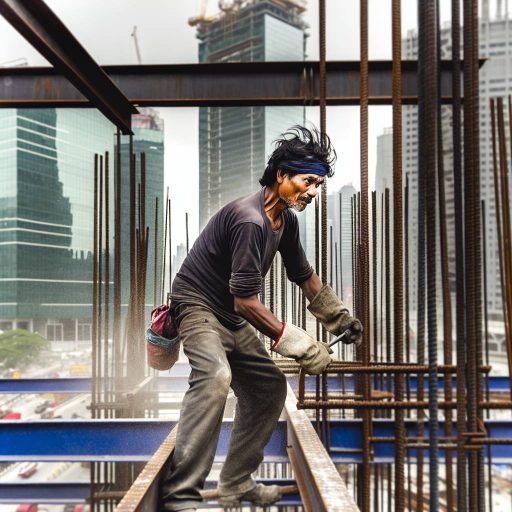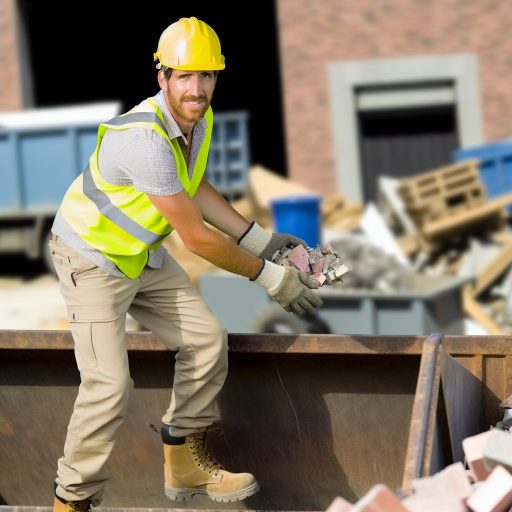Introduction:
A professional drywall installer is a crucial part of the construction industry.
They are responsible for installing drywall surfaces in residential and commercial buildings.
Their work involves measuring, cutting, and attaching drywall sheets to create walls and ceilings.
Without their expertise, buildings would lack the necessary structures for interior finishes.
This makes their role essential in creating functional and aesthetically appealing spaces.
This blog post will provide a detailed glimpse into the day-to-day activities and challenges faced by a professional drywall installer.
It will offer insights into their demanding yet rewarding work.
Background and Training:
- Education and training required to become a professional drywall installer.
- Importance of hands-on experience in the field.
- Certification and licensing requirements.
To become a professional drywall installer, individuals usually need a high school diploma or equivalent.
Some technical schools offer programs specific to drywall installation.
Hands-on experience is crucial in mastering the skills required for drywall installation.
It allows professionals to fine-tune their techniques and become more efficient.
While certification is not always mandatory, some states require drywall installers to be licensed.
This ensures that professionals meet certain standards and adhere to regulations.
Daily Responsibilities:
Arriving at the job site early in the morning is a routine for a professional drywall installer.
They start their day by reviewing the project plans provided by the contractor or project manager.
This helps them understand the scope of work and requirements for the day.
One of the crucial tasks of a drywall installer is measuring and cutting drywall sheets to fit specific dimensions.
They use tape measures, T-squares, and cutting tools to ensure precise cuts that match the project’s specifications.
Accuracy is key in this step to avoid any wastage of material.
After cutting the drywall sheets, the installer proceeds to the installation phase.
Transform Your Career Today
Unlock a personalized career strategy that drives real results. Get tailored advice and a roadmap designed just for you.
Start NowUsing specialized tools such as screws, drills, and levels, they carefully attach the drywall panels to the framing of the building.
This requires attention to detail and proper technique to ensure a seamless finish.
Once the drywall panels are in place, the installer moves on to applying finishing touches.
This includes using joint compound to fill in gaps and seams between the panels.
They also sand down the compound once it dries to create a smooth surface for painting or wallpapering.
Throughout the day, a professional drywall installer needs to maintain a clean and organized work environment.
They often work in teams, coordinating with other tradespeople on the job site to complete projects efficiently.
Communication and teamwork are essential skills in this line of work.
In addition to the physical aspects of the job, drywall installers also need to have a good understanding of building codes and safety regulations.
They must ensure that their work meets industry standards and that the construction site remains safe for themselves and others.
At the end of the day, a professional drywall installer takes pride in seeing the transformation they have helped create.
From bare studs to finished walls, their craftsmanship plays a crucial role in shaping the interior spaces we live and work in.
It is a job that requires skill, precision, and a passion for creating quality finishes.
Find Out More: Dockworker’s Role in Port Security and Safety
Challenges and Problem Solving:
Common challenges faced by drywall installers on the job:
- Irregularities in wall surfaces can make installation difficult.
- Heavy panels can be challenging to maneuver and lift.
- Poorly framed walls can lead to uneven drywall finishes.
- Working in tight spaces can limit movement and hinder progress.
Problem-solving skills required to overcome obstacles:
- Ability to accurately measure and cut drywall panels to fit.
- Knowledge of various techniques to address wall imperfections.
- Use of proper tools and equipment to ensure precise installation.
- Communication with other trades to coordinate work efficiently.
Dealing with unexpected issues such as uneven walls or hidden pipes:
- Identify the cause of uneven walls and address underlying problems.
- Utilize shims or spacers to create a level surface for installation.
- Employ techniques such as feathering to blend uneven areas seamlessly.
- Use stud finders or X-ray equipment to locate and avoid hidden pipes.
As a professional drywall installer, it is essential to be prepared to face a variety of challenges on the job.
From working with imperfect surfaces to resolving unexpected issues, problem-solving skills are crucial in ensuring a successful installation.
Showcase Your Business Today
Reach thousands of readers actively exploring professional services. Publish your business profile and grow your audience now.
Publish NowBy equipping oneself with the necessary knowledge and techniques, drywall installers can tackle any obstacle that comes their way.
Discover More: Top Skills Needed for Success as a Maintenance Worker
Collaboration with Other Professionals:
Collaboration with other professionals is a crucial aspect of a professional drywall installer’s job.
The success of a project often relies on effective teamwork and communication between various trades involved in the construction process.
One of the key collaborators for a drywall installer is contractors.
They are typically responsible for overseeing the entire project and ensuring that each trade is working together seamlessly.
As a drywall installer, working closely with contractors is essential to understanding project requirements and deadlines.
Architects and designers also play a significant role in the collaboration process.
They provide the creative vision and specifications for the project, including the design and layout of the walls.
Drywall installers must communicate effectively with architects and designers to ensure that their vision is accurately translated into the final product.
Effective communication is essential in ensuring that project deadlines are met.
Clear and consistent communication between all parties involved helps to prevent delays and ensures that everyone is on the same page regarding the project timeline.
Drywall installers must provide regular updates on their progress and raise any issues or concerns promptly to keep the project on track.
In many construction projects, integrating electrical and plumbing systems into the walls is necessary.
This requires close coordination with electricians and plumbers to ensure that the necessary infrastructure is in place before the drywall installation begins.
Collaboration with these professionals helps to streamline the construction process and avoid potential conflicts during installation.
Overall, collaboration with contractors, architects, designers, electricians, and plumbers is a fundamental aspect of a professional drywall installer’s job.
By working closely with other professionals and communicating effectively, drywall installers can ensure that projects are completed on time and to the highest quality standards.
Find Out More: Understanding the Pipelayer’s Work Environment

Physical Demands
Being a professional drywall installer is a physically demanding job that requires a lot of strength and stamina.
You are constantly moving heavy materials and equipment while on the job site.
This means you will be lifting heavy drywall sheets, carrying buckets of mud, and using tools that require physical exertion.
Heavy Lifting
- Drywall sheets can be heavy and awkward to maneuver, especially when working on ceilings.
- It’s important to use proper lifting techniques to prevent back injuries.
- Consider using a drywall lift to help position sheets in place.
Standing for Long Periods
- Drywall installation involves a lot of standing, bending, and reaching.
- Make sure to wear comfortable shoes with good support to reduce strain on your feet and legs.
- Take breaks as needed to rest and stretch your muscles.
Safety Precautions
Ensuring your safety on the job site is crucial when working as a drywall installer.
The nature of the job exposes you to various hazards that can result in injuries if proper precautions are not taken.
Here are some important safety measures to keep in mind:
Proper Safety Gear
- Always wear personal protective equipment such as gloves, safety glasses, and a dust mask.
- Use ear protection when working with loud tools such as a drywall saw or sander.
- Avoid loose-fitting clothing that can get caught in equipment.
Preventing Injuries
- Be mindful of your surroundings and watch out for potential hazards on the job site.
- Inspect your tools and equipment regularly to ensure they are in good working condition.
- Follow proper safety protocols when using ladders or scaffolding to reach high areas.
Staying Safe on the Job Site
- Communicate with your team members to coordinate tasks and avoid accidents.
- Keep the work area clean and organized to prevent tripping hazards.
- Stay focused and attentive while working to reduce the risk of mishaps.
You Might Also Like: Painting for Beginners: Tips to Get You Started
Job Satisfaction and Rewards:
- Fulfillment derived from seeing a project come together
- Pride in delivering high-quality workmanship
- Personal satisfaction in contributing to the construction of homes and buildings
As a professional drywall installer, the job satisfaction and rewards that come with the role are immense.
From the moment I begin a project to the final touches, there is a sense of fulfillment that comes from seeing everything come together seamlessly.
The satisfaction derived from transforming a bare space into a finished room is unmatched.
Knowing that my skills and expertise have contributed to creating a functional and aesthetically pleasing environment is incredibly rewarding.
One of the aspects that bring me the most pride is delivering high-quality workmanship.
The precision and attention to detail required in drywall installation ensure that the final result is flawless.
Seeing the perfect lines and smooth finish is a testament to my craftsmanship.
Moreover, knowing that my work plays a key role in the construction of homes and buildings adds a deeper layer of personal satisfaction.
Every project I work on contributes to creating spaces where families will make memories and businesses will thrive.
The thought that my work will be part of people’s everyday lives is truly gratifying.
The job satisfaction and rewards that come with being a professional drywall installer are multifaceted.
From the pride of delivering high-quality work to the personal fulfillment of contributing to the construction industry, this role offers a sense of accomplishment that is unparalleled.
Daily Life of a Professional Drywall Installer
After getting a glimpse into the daily life of a professional drywall installer, it’s clear that this job requires a unique blend of skills and determination.
Showcase Your Business Today
Reach thousands of readers actively exploring professional services. Publish your business profile and grow your audience now.
Publish NowFrom measuring and cutting drywall to hanging and finishing it, the process is intricate and demanding.
Despite the physical challenges and the need for precision, these professionals exhibit a strong work ethic and attention to detail.
In appreciation of their hard work and dedication, it’s important to recognize the essential role that professional drywall installers play in the construction industry.
Their expertise and craftsmanship are vital in creating functional and aesthetically pleasing interiors.
For those considering a career in this field, it’s important to understand the technical aspects of the job.
Prepare for the physical demands it entails. However, the rewards of seeing a project come together are immeasurable.
By knowing that you have contributed to the creation of a space, the sense of fulfillment is profound.
Whether you are interested in pursuing a career as a professional drywall installer or simply admire the expertise in the field, take a moment to appreciate the hard work that goes into each project.
Professional drywall installers truly make a difference in transforming spaces and bringing architectural visions to life.
Additional Resources
Carpenters : Occupational Outlook Handbook: : U.S. Bureau of …
Essential or Expendable? The Construction Trades on the Frontlines …




